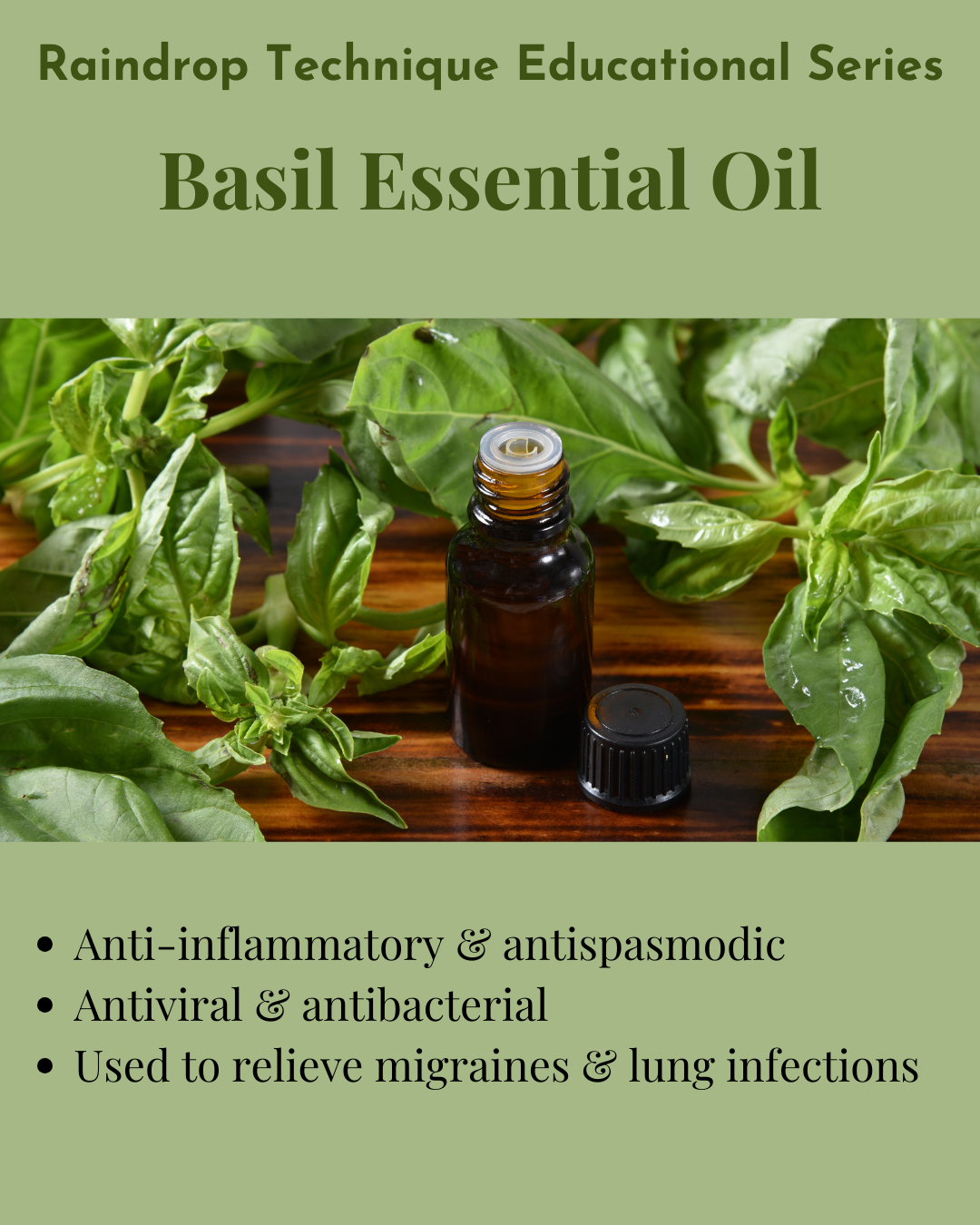Basil Essential Oil
Basil essential oil is the third oil I apply to the bottoms of your feet using reflexology as well as the third essential oil applied to your back. And you’re going to get tired of me telling you each week that this is one badass essential oil. Because basil is–as well as every other essential oil in the Raindrop Technique. Why? Because Mother Nature is amazing and unlike most medications these days, plants are multitaskers and capable of treating a myriad of ailments. So, without further ado, let’s get into Basil essential oil.
Basil has many medicinal properties.
The Nerdy Stuff
Basil, just like oregano and thyme, is from the Lamiaceae botanical family and has the Latin name Ocimum basilicum. Basil is native to the tropical portions of Asia as well as Africa and is now grown widely throughout Europe and the Americas. The essential oil is steam distilled from basil’s leaves, stems, and flowers when the herb is flowering.
Basil’s key constituents are dependent on the particular variety of O. basilicum. I’ve listed the major ones for the two primary variations, purpureum and thyrsiflora one may get from purchasing a basil essential oil, but have left out the percentages since these will vary widely between the two variations. O. basilicum variation purpureum’s primary constituent will be methyl chavicol (estragol), while O. basilicum variation thyrsiflora’s will be linalool:
Linalool
A naturally occurring alcohol, linalool has a floral, spicy aroma and has anti-inflammatory, antimicrobial, anticancer, anxiolytic (anti-anxiety), and antidepressant properties. (https://www.sciencedirect.com/topics/neuroscience/linalool#:~:text=Linalool%20is%20an%20acyclic%20monoterpene,treatment%20of%20certain%20neurological%20disorders.)
Methyl chavicol (estragole)
A colorless liquid with a strong, spicy green herbal odor, it is used in many aromatic products such as cosmetics, perfumes, detergents, and shampoos. It is useful for relieving muscle tension, stomach cramps, and is antispasmodic. It is also excellent for digestive issues arising from stress, respiratory problems, and mental fatigue. (https://www.essentialoil.in/methyl-chavicol.html)
Eugenol
Found primarily in cloves, eugenol has a spicy scent and is used as a flavoring, a pain reliever, and antiseptic oil. It has been used in dentistry to treat toothaches and has anti-inflammatory, antioxidant, antifungal, and analgesic properties. (https://pubchem.ncbi.nlm.nih.gov/compound/Eugenol)
1,8-cineole (eucalyptol)
Eucalyptol has antimicrobial and antiviral properties, and is anti-inflammatory, an antioxidant, and an analgesic. It has also been used to treat respiratory disorders, including chronic obstructive pulmonary disease, asthma, and more. (https://www.sciencedirect.com/science/article/pii/S0753332223012659)
Camphor
This has a strong mothball-like odor and has topical applications as an anti-itch or anti-infective agent. It should not be ingested in any product containing more than 11% camphor due to rapid onset of toxic effects so stick to topical or aromatic applications only. Basil essential oil contains well under 11% of camphor in any variety. (https://pubchem.ncbi.nlm.nih.gov/compound/Camphor)
Actions/Properties
Now, let’s get down to the fun stuff–what basil essential oil has been used for historically and what its medicinal properties are (a.k.a., why we want to use basil essential oil). Historically, basil has been used widely in the Ayurvedic tradition (the ancient and still used Indian medical system) and is called tulsi. It is used for respiratory issues such as bronchitis, asthma, sinusitis, colds, and coughs, as well as an antidote for poisonous insect and snake bites. In China, basil has been used to treat stomach and kidney ailments. And basil leaves were powdered and inhaled to treat migraines and chest infections.
Medicinal properties of basil essential oil include:
Antidepressant
Restorative (makes you feel more energized)
Carminative (relieves flatulence)
Antiseptic
Antiviral
Antibacterial
Anti-inflammatory
Antispasmodic
Digestive aid
Expectorant (for coughs)
Calms nerves
Stimulates circulation
Stimulates adrenal cortex (which produces hormones that regulate blood pressure, blood sugar, and stress response)
Using Basil Essential Oil
Basil is pretty non-toxic and non-irritating but should still be avoided during pregnancy because it may stimulate uterine contractions. Otherwise, it is a very safe essential oil.
In the Raindrop Technique, I apply it using a reflexology technique to the bottoms of your feet and using effleurage (light touch) to your back. This is also the first essential oil that I massage into the muscles on your back using a circular motion called the “spinal tissue pull.”
At home, you are pretty free to use basil essential oil however you like due to its non-toxic nature. In the diffuser, it can blend well with bergamot, clary sage, and lime oils for a fresh, green scent. Topically, I will always recommend that you do a skin patch test before applying it widely without dilution–or, you could always dilute it with lotion or a neutral oil before applying to your skin.
Ingesting essential oils always carries a higher risk of an adverse reaction, but if you do ingest basil essential oil, please dilute it with the beverage of your choice and use only a drop or two. That being said, please recall from my blog on essential oils that most essential oils are more useful and potent when used topically or aromatically than when ingested. Use basil as an herb to ingest it for its medicinal properties, rather than its essential oil.
Additional Sources
Encyclopedia of Essential Oils: The complete guide to the use of aromatic oils in aromatherapy, herbalism, health and well-being. Julia Lawless. Thorson’s Publishing, 2012.
Essential Oils Pocket Reference (6th ed.). Life Science Products and Publishing, 2014.
Chemical composition and some biological activities of the essential oils from basil Ocimum different cultivars. Avetisyan, A., Markosian, A., Petrosyan, M. et al. BMC Complementary Medicine and Therapies 17(60), 2017. https://doi.org/10.1186/s12906-017-1587-5

